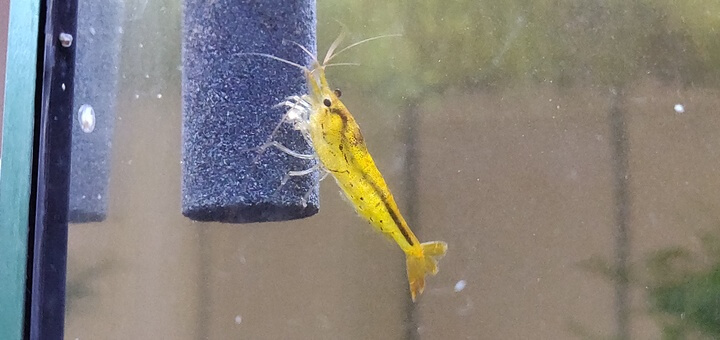What makes a filter shrimp safe?
A shrimp safe filter will pose minimal to no risk to baby shrimp and adults alike.
Generally you’ll want to look for filters which can support a fine filter foam over the inlet pipe. This will prevent any tiny shrimp being accidentally pulled into the pump and getting stuck or injured inside.
Do shrimp need filters?
Shrimp are very sensitive to ammonia and nitrite so it’s widely recommended that you cycle your shrimp tank fully before introducing any livestock. This just means running the filter long enough to build a healthy amount of beneficial bacteria which will keep the ammonia and nitrite levels safe.
However, with careful planning it’s possible to a filterless setup if you have a mature, heavily planted tank for example. This method is commonly referred to as the Walstad method, named after Diana Walstad who documented the idea.
Without a filter
The Walstad method is one way of achieving a healthy tank without needing to run any mechanical filtration. This involves filling the aquarium with a lot of plants that will pull almost all of the ammonia out from the water.
This method sounds simple, but it really does require a large amount of plants to be safe enough for shrimp. Floating plants are powerful here as they can grow incredibly quickly with access to the carbon dioxide in the air along with the water’s nutrients.
You’ll want to have the tank running stable for a few months minimum before introducing life to give the plants enough time to establish themselves. Otherwise there’s a risk they won’t be able to absorb the ammonia and other waste as fast as your livestock produce it.
Maintenance
You should try to clean your filter sponges at least every few months. You will notice your water starting to become cloudy if the sponges need to be cleaned.
A surprising amount of detritus and waste can build up in the foam in a short amount of time.
It’s important to clean and rinse your sponges in old water instead of tap water for example. Using old water will prevent harm to the helpful bacteria living inside, but tap water with chlorine will kill a lot of this bacteria and potentially crash your cycle.
Sponge filter
A sponge filter is the most popular choice for shrimp tanks.

They work by pushing air into a column behind a sponge or foam, when the air floats up out of the column, water from outside wants to fill that void. The water goes through the foam and any large particles get caught on the outside.
All that’s required is the sponge filter itself and an air pump. There’s no risk of leaks like could be possible with a hang on back filter for example. There’s also no real risk to shrimp if they somehow manage to get inside, there aren’t any moving parts like motors, it’s just water and air inside.
Hang on Back (HOB)
A hang on back filter, as the name implies, hooks on to the top of your aquarium walls to provide a waterfall-like flow. A water pump will pull water in from its inlet up into a chamber outside of the tank and let it fall back in as the chamber fills.
Hang on backs give you the ability to have a massive amount of filtration, both biological and mechanical.
Mechanical filtration is handled by the foam/sponge on the inlet pipe, sucking up any larger particles floating around.
Biological filtration can be handled by adding items like ceramic rings into the water chamber. This gives the beneficial bacteria a huge amount of extra surface area to grow on.
You can even add some emersed plants into the chamber to pull even more nutrients out of the water.

Matten filter
Matten filters are almost a hybrid of hang on backs and sponge filters. They’re normally built into a corner or against a wall of the aquarium, dividing the two sides with a wall of sponge. A water pump is placed behind the wall and pushes the water over the top and back into the “living” side of the tank.
The giant sponge walls are an amazing place for biofilm and dust to collect, making for a great place to feed your shrimp.
Airstone
Whilst not really a filter, some keepers will use only an airstone to provide some aeration into their aquarium.

This should only be attempted with a heavily planted tank that will be able to handle the biological filtration requirements. Only a fairly small amount of bacteria will be able to live on the airstone itself, depending on the size.

